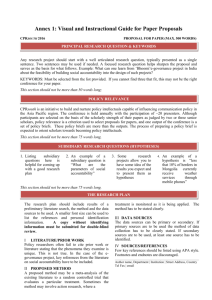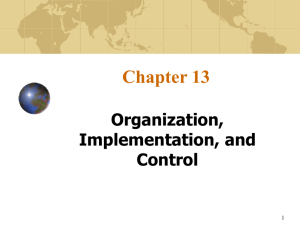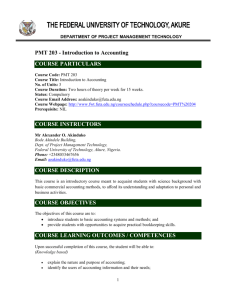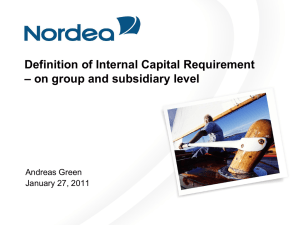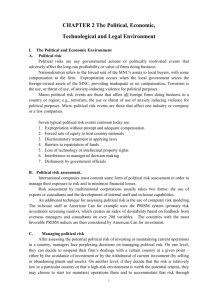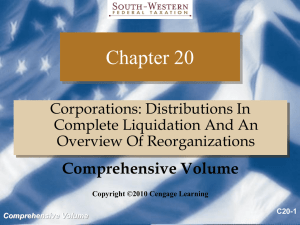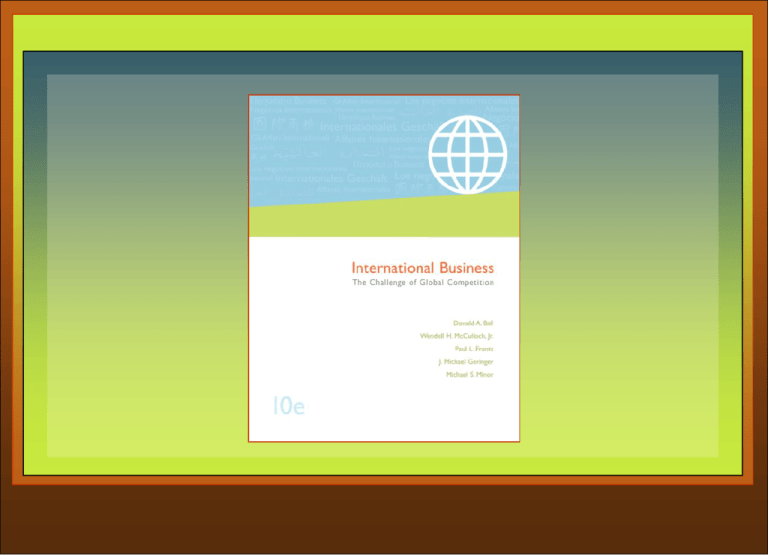
This chapter covers:
18
•Design of
organizational
structures
•Organizational
dimensions
Organizational Design
And Control
•Organizational forms
•The virtual
corporation
•Decision making in
an IC
•Control of a joint
venture
•Reports needed by
an IC
International Business
by Ball, McCulloch, Frantz,
Geringer, and Minor
McGraw-Hill/Irwin
Copyright © 2006 The McGraw-Hill Companies, Inc. All rights reserved.
Chapter Objectives
Explain why the design of organizational structure is
important to international companies
Understand the organizational dimensions that must be
considered when selecting organizational structures
Discuss the various organizational forms
Understand the concept of the virtual corporation
Explain why decisions are made where they are among parent
and subsidiary units of an international company
Understand how an IC can maintain control of a joint venture
List the types of information an IC needs to have reported to it
by its units around the world
18-2
Organizational Structure
Organizational structure
The way organization
arranges its various
domestic and
international units and
activities
The relationships among
these components
Determines where formal
power and authority will
be located
Presented in an
organization chart
18-3
Organization Design
Organization design deals with how an
international business should be organized in order
to ensure its worldwide business activities are able
to be integrated in an efficient and effective manner
Structures and systems must be consistent with each
other and with the environmental context
Size and complexity of the organization must be
considered in design
Structure must be able to evolve over time in order to
respond to change
18-4
Design Concerns
Organizational Design Concerns
Two concerns that management faces in
designing the organizational structure
Finding the most effective way to
departmentalize to take advantage of the
efficiencies gained from specialization of labor
Coordinating the activities of those
departments to enable the firm to meet its
overall objectives
18-5
Design Dimensions
18-6
Product and technical
expertise regarding the
businesses
Geographic expertise
regarding the countries and
regions
Customer expertise
regarding the client groups,
industries, market segments,
or population groups
Functional expertise
regarding the value chain
activities
Evolution of the International Company
International Division
A division in the
organization that is at the
same level as the
domestic division and is
responsible for all nonhome country activities
Organization on a
regional or geographic
basis
As overseas operations
grow global structures are
formed
18-7
Management changes to
global product or global
geographic form to
Be more capable of
developing competitive
strategies
Obtain lower production
costs
Enhance technology
transfer and the
allocation of resources
Global Corporate Form
Product
Product divisions responsible for the worldwide
operations such as marketing and production of
products
Each division generally has regional experts
Eliminates duplication of product experts
Creates a duplication of area experts
18-8
Global Corporate Form
Geographical Regions
Responsibilities for all
activities under area
managers who report
directly to the CEO
This kind of organization
simplifies the task of
directing worldwide
operations
Every country is
clearly under the
control of someone
who is in contact with
headquarters
18-9
Global Corporate Form
Geographical Regions
Used for both multinational and global companies
Used by
Companies that manufacture products with a low or
stable technological content that require strong
marketing ability
Firms with diverse products
Producers of consumer products
Creates duplication of product and functional
specialists
18-10
Global Corporate Form
Function
Few firms are organized
by function at the top
level
Senior executives
responsible for each
functional area report
to CEO
Users of the functional
form are those with a
narrow and highly
integrated product mix
18-11
Hybrid Forms
A mixture of the
organizational forms is
used at the top level and
may or may not be
present at the lower
Often result of regionally
organized company
introducing new and
different product line or
Firm selling to sizable,
homogeneous class of
customers
Global Corporate Form
Matrix
Organization
Organization based on one or two dimensions
superimposed on organization based on another
dimension
Evolved from attempt to mesh product, regional,
and functional expertise
Requires multiple managers to agree on decision
Matrix overlay attempts to correct this problem
18-12
Strategic Business Units
An organizational form
in which
product divisions
have been defined as
though they were
distinct, independent
businesses
Most SBUs are based on
product lines
18-13
Changes in Organizational Form
Pressure to act more quickly, reduce costs and
improve quality have created new forms
Reengineering to
18-14
reduce levels of middle management
restructure work processes
reduce fragmenting across departments
empower employees
improve communication
respond more quickly
become more innovative
Current Organizational Trends
Virtual Corporation
18-15
Coordinates activity to
deliver value to
customers using
resources outside
traditional boundaries
Relies to a great extent on
third parties to conduct
its business
Also called a network
corporation
Advanced by technology
Advantages
Permits greater flexibility
Forms a network of
dynamic relationships
taking advantage of the
competencies of other
organizations
Disadvantage
Potential to reduce
management’s control
over the corporation’s
activities
Current Organizational Trends
Horizontal Corporation
Gives flexibility to
respond quickly
“antiorganzation”
removes constraints of
conventional structures
Employees worldwide
create, build, and market
the company’s products
through a carefully
cultivated system of
interrelationships
18-16
Control
Where Are Decisions Made?
All at IC headquarters
All at subsidiary level
Combination
Variables determining the location of decision making
Product and Equipment
Competence of subsidiary management
Size of the international company and how long it has
been one
Detriment of a subsidiary for the benefit of the
enterprise
Subsidiary frustration
18-17
Control
Product and Equipment
Standardized product
affiliates have to follow
company policy
Without global product
policy, still attempt to
standardize as much as
possible
If profit potential greater
when subsidiary
customizes, subsidiary
can proceed with parent
approval
18-18
Competence of Subsidiary
Management depends on
How well do executives
know one another
How well do they know
company policies
Understanding of host
country conditions
Distances between home
and host countries
Size and age of parent
company
Control
Greater reliance on
subsidiary management if
18-19
Executives are moved
around between
headquarters and
subsidiaries
HQ less familiar with host
country
Greater distance
Smaller company lacks
internationally experienced
managers and cannot afford
to hire them
Control
Benefiting the
Enterprise to the
Detriment of a
Subsidiary
18-20
IC can source raw
materials and
components, locate
factories, allocate orders
and govern intrafirm
pricing that may benefit
the IC but be a detriment
to the subsidiary
Moving Production Factors
Which Subsidiary Gets the
Order
Transportation, production,
tariffs, currency, backlogs
Multicountry Production
Cost, labor, taxes, market,
currency, political stability
Economies of scale
Which Subsidiary Books the
Profits
Taxes, currency controls,
labor relations, political
climate, social unrest
Control
Subsidiary Frustration
Management of subsidiaries must be motivated
and loyal
If all decisions made at HQ they can lose incentive
and prestige or face with their employees and the
community
They may become hostile and disloyal
HQ management should delegate as much as
reasonably possible
Subsidiary managers should be kept informed
18-21
Joint Ventures and Subsidiaries Less
than 100 Percent Owned
A joint venture may be
A corporate entity between
an IC and local owners
A corporate entity between
two or more companies that
are foreign to the area where
the joint venture is located
One company working on a
project of limited duration
in cooperation with one or
more other companies
18-22
Joint Ventures and Subsidiaries Less
than 100 Percent Owned
Loss of freedom and
flexibility because
shareholders can block HQ
efforts to
Move production factors
Fill an order from another
affiliate or subsidiary
Shareholders may bring
legal pressures
Political pressures
18-23
Methods HQ can use to
maintain control include
A management contract
Control of the finances
Control of the technology
Putting people from the
IC in important executive
positions
Joint venture partner will
want their own or host
government personnel in
executive positions
Control
For controls to be effective
all operating units of an international company
must provide headquarters with
timely, accurate, and complete reports
Types of reporting required
Financial
Technological
Market opportunity
Political and economic
18-24
De-Jobbing
Mass production and
large organizations are
disappearing
New computer and
communication
technologies are “dejobbing” the workplace
Fixed jobs are being
replaced with tasks
performed by evolving
teams
18-25
De-Jobbing
Traits of Companies with De-Jobbed Workers
They encourage employees to make operating
decisions that used to be reserved for managers
They give employees the information they need
to make such decisions
They give employees lots of training to create an
understanding of business and financial issues
that used to concern only an owner or executive
They give employees a stake in the fruits of their
labor--a share of the profits
18-26



